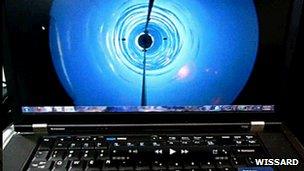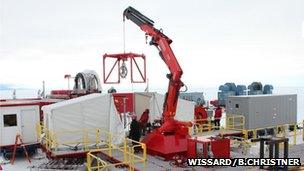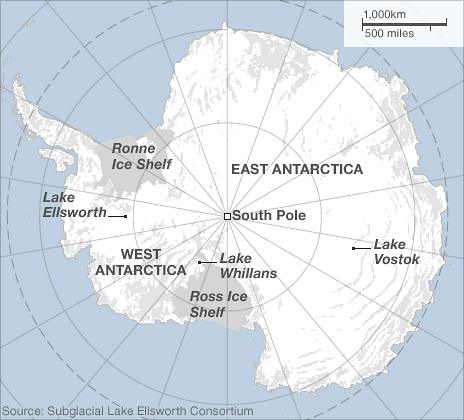Drill reaches Antarctica's under-ice Lake Whillans
- Published

An image from the Wissard borehole camera
An American attempt to bore down into Lake Whillans, a body of water buried almost 1km under the Antarctic ice, has achieved its aim.
Scientists reported on Sunday that sensors on their drill system had noted a change in pressure, indicating contact had been made with the lake.
A camera was then sent down to verify the breakthrough.
The Whillans project is one of a number of such ventures trying to investigate Antarctica's buried lakes.
In December, a British team abandoned its efforts to get into Lake Ellsworth after encountering technical difficulties.
The Russians have taken water samples from Lake Vostok, although they have yet to report any big discoveries.
Lake Whillans is sited in the west of Antarctica, on the southeastern edge of the Ross Sea.
It is less of a lake and more of a dense system of streams, almost like a delta, that covers some 60 square km. The liquid body is quite shallow - just a few metres in depth.
The Whillans Ice Stream Subglacial Access Research Drilling (Wissard) team has been using a hot-water drill to melt a 30cm-diameter hole through the overlying ice.
Breakthrough to the lake surface was reported on the project's website.

Drilling operations had to cut through 800m of ice
The intention, now that the hole is secure, is to lower various sampling tools and sensors into the lake to study its properties and environment.
Some of the samples will be assessed onsite at the ice surface in temporary labs, and others will be returned to partner universities for more extensive analysis.
The Wissard blog said the thickness of the overlying ice was measured to be 801m, which agreed well with the estimates from seismic imaging.
More than 300 large bodies of water have now been identified under the White Continent.
They are kept liquid by geothermal heat and pressure, and are part of a vast and dynamic hydrological network at play under the ice sheet.
Some of the lakes are connected, and will exchange water. But some may be completely cut off, in which case their water could have been resident in one place for thousands of years, and that means they probably play host to microorganisms unknown to modern science.
The Whillans area is not as deep as either Vostok (4km) or Ellsworth (3km), and its water is exchanged frequently by the under-ice streams over months and years.
Indeed, satellite measurements, external have revealed the lake rapidly filling and draining. This was evident from measurements of the height of the overlying ice surface, which raised itself in response to an increase in water volume, and then slumped down as the water spread to a new location.

Scientists are keen to study Antarctica's subglacial hydrological systems because liquid water beneath the ice sheet will influence its movement (the ice above Lake Whillans is moving at about 300m per year). Modelling the sheet's long-term stability in a warming world has to take this into account.
These under-ice environments may also provide fascinating insights into the potential habitability of some moons in the Solar System.
Europa, a satellite of Jupiter, and Enceladus, which orbits Saturn, both have large volumes of liquid water buried beneath their icy crusts.
Astrobiologists think such moons are promising places to go look for extra-terrestrial microorganisms.
Dr David Pearce from the UK's Ellsworth team described the Whillans breakthrough as "exciting".
"I always viewed the projects as very complementary," the British Antarctic Survey researcher told BBC News.
"The Ellsworth project was very much in the Trans-Antarctic Mountains, at the highest point. Vostok was on the plateau region in the central East Antarctic, and the Whillans project was towards the coast in a delta region; and between the three projects, they would have given us a really good understanding of what's happening under the ice," he explained.
"We'll need to wait to see what they find [at Whillans], but it wouldn't surprise me if there were marine organisms or evidence of marine incursion. If Whillans is open to the marine system, it is open to incursion."
Jonathan.Amos-INTERNET@bbc.co.uk and follow me on Twitter: @BBCAmos, external
- Published16 February 2012
- Published27 December 2012
- Published27 December 2012
- Published19 December 2012
- Published8 February 2012